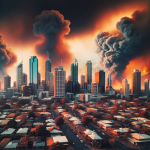Australia Faces Escalating Bushfire Risks
As temperatures rise and weather patterns grow erratic, Australia’s bushfire risk is intensifying this season, raising alarms for communities and emergency responders. Experts are warning that the upcoming months could mark one of the most severe bushfire seasons in recent memory, similar to or even worse than the catastrophic “Black Summer” bushfires of 2019–2020. This warning comes at a time when the world is also witnessing unusual wildfire activity during California’s winter months, drawing sobering parallels between the two regions and highlighting the urgency of climate action.
In this blog, we explore Australia’s mounting bushfire risks, how the crisis compares to the recent wildfires in California, and steps that both countries are taking—alongside what individuals can do to stay prepared as wildfire seasons become the “new normal.”
Rising Heat and Frequent Droughts: What Fuels Australia’s Bushfires?
Australia’s bushfire problem stems from several overlapping factors, many of which are exacerbated by climate change. Here are some of the main drivers behind the escalating risk:
- Prolonged Periods of Drought: Much of Australia has been experiencing prolonged dry spells, which dehydrate vegetation and make it highly flammable.
- Warmer Temperatures: Rising global temperatures due to climate change create the ideal conditions for bushfires to ignite and spread rapidly.
- Stronger Winds: Increasingly volatile wind patterns not only exacerbate fire intensity but also hinder firefighting efforts, as embers can travel several kilometers.
- Vegetation Growth During Wet Seasons: Ironically, heavy rains during La Niña periods can lead to increased fuel load—plants that later dry out and serve as fire fodder during hotter months.
With these factors building up, 2023 is shaping up to be an intense fire season, igniting concerns across Australia’s eastern and southern regions. Authorities warn that communities in New South Wales, Victoria, South Australia, and Tasmania need to brace themselves for potential disruptions and threats to their safety.
California’s Wildfire Crisis Offers Stark Lessons
While Australia’s bushfire season looms, California—another region notorious for wildfires—is already dealing with an unusual and alarming wildfire outbreak during its winter months. Historically, California’s worst fires occur between the late summer and early fall. However, the state has recently seen significant wildfires erupt even during its supposed “off-season.”
California’s winter wildfires are driven by its own unique set of conditions:
- Santa Ana Winds: Hot, dry winds from the desert exacerbate the situation by fanning flames and spreading them into residential areas.
- Persistent Drought: California, like Australia, has been grappling with extreme droughts that dry out natural vegetation and increase flammability.
- Population Growth in Wildland Areas: Urban development encroaching on fire-prone land has amplified the risks to human lives and property.
By examining California’s wildfire outbreaks, Australian authorities can draw useful parallels and adopt some of the strategies that the United States employs. For example, the U.S. Forest Service and National Guard often pre-position firefighting teams and equipment during peak wildfire seasons. A similar approach could benefit Australian firefighting strategies in vulnerable regions.
What Australia Can Learn From California
California’s ongoing wildfire response highlights the importance of preparation, early warning systems, and community awareness campaigns. Below are some lessons Australia can consider applying or enhancing:
- Invest in Wildfire Technology: California uses cutting-edge satellites and AI-driven technology to detect fires faster than traditional methods.
- Stronger Evacuation Protocols: Established evacuation routes and community-wide drills help save lives when disaster strikes.
- Controlled Burns: The use of prescribed or “controlled” burns to clear out combustible vegetation helps reduce the severity of uncontained wildfires.
- Public Awareness Campaigns: Increasing public knowledge about fire preparedness has proven effective in minimizing property damage and loss of life.
Nevertheless, Australia faces distinct challenges due to its unique climate and ecosystem, and its solutions must be tailored accordingly.
The Role of Climate Change
Both Australia and California serve as sobering reminders that climate change is not a distant issue of tomorrow—it is here, and its impacts are being felt globally. Rising temperatures and erratic weather patterns are amplifying the severity, frequency, and unpredictability of wildfires.
What does the science say?
- According to the latest UN Climate Report, global temperatures are on track to rise by 2.5°C by the end of the century unless immediate action is taken.
- In Australia, climate scientists predict that peak fire-weather conditions will arrive earlier in the season and last longer due to shifting weather patterns.
- California faces similar forecasts, with the likelihood of wildfires doubling in high-risk areas by 2100.
While governments worldwide are pledging to combat climate change, the clock is ticking. The longer action is delayed, the more challenging it will be to manage these crises in the future.
What Can Communities and Individuals Do?
While bushfires may be seemingly uncontrollable forces of nature, that doesn’t mean that individuals and communities are powerless. Here’s what you can do to stay safe during bushfire season:
- Stay Informed: Regularly monitor emergency broadcasts, weather reports, and fire danger ratings in your region.
- Prepare an Emergency Plan: Develop a family evacuation plan and ensure that everyone knows what to do in case of fire.
- Maintain Defensible Space: Clear vegetation, leaves, and flammable debris from around your property to slow down fire spread.
- Prepare an Emergency Kit: Stock up on essentials like food, water, batteries, and flashlights. Don’t forget critical documents and medication.
- Follow Fire Bans: Adhere to local restrictions on outdoor burning and campfires to minimize the risk of manmade fires.
Government Action and Policy: What Needs to Change?
To tackle the mounting bushfire challenges, both federal and local governments must adopt stronger, future-focused policies. Key areas to address include:
- Funding Firefighting Infrastructure: Allocate more resources for equipment, personnel, and technology to strengthen firefighting capacity.
- Climate Policy: Accelerate decarbonization efforts and actively work towards the Net Zero emission goals to address the root causes of climate change.
- Community Engagement: Encourage local initiatives such as bushfire awareness workshops and training for residents in fire-prone areas.
- Reforesting Burn Zones: Invest in regenerating forested areas destroyed by fires with fire-resistant, native vegetation.
Final Thoughts: The Time for Action Is Now
The parallel crises in Australia and California have made one thing abundantly clear: wildfires, driven by climate change, are becoming a year-round threat. As history has shown, inaction can be deadly. Now is the time for governments, communities, and individuals to work collaboratively to address wildfire risks while tackling the broader climate crisis.
For Australia, the reality of another potential “Black Summer” should serve as a wake-up call. Taking proactive, strategic measures now will not only mitigate future disasters but also save lives and livelihoods.
Wildfires may be inevitable, but by understanding the risks and employing smarter strategies, we can reduce their catastrophic impact and protect the places we call home.


